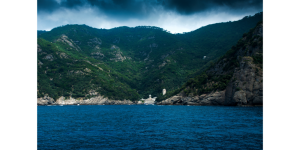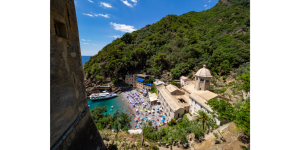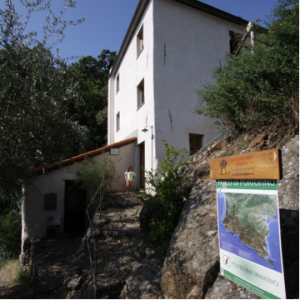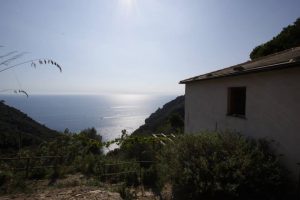There is a magical place in Liguria, San Fruttuoso, which can only be reached by land – travelling down the entire Portofino nature reserve, from the top of Camogli, in that hamlet 269 metres above sea level called Ruta – or by the sea – by ferry from Santa Margherita Ligure or, on the other side, from Camogli.

The name San Fruttuoso
The place is called San Fruttuoso, after the Catalan bishop whose ashes are preserved here, arriving after a crossing from the Spanish coast following – it is said – the Arab invasion.
The Dorias
There is a splendid abbey dedicated to the saint and a tower built by the well-known and wealthy Doria family of Genoa, the architects of several conquests of the Ligurian city.

A day at San Fruttuoso
The classic tourist usually goes to San Fruttuoso in a day: a splendid sea crossing with the spectacle of the Ligurian coastline, a swim in the emerald water, a visit to the abbey and the Doria Tower, a meal in one of the bars and/or restaurants in this precious handkerchief of land and sand, a gift from the forest to man. You can eat and drink in this crystal-clear bay and find a spot of sunshine on one of the two small beaches surrounding the abbey.
Sleeping in San Fruttuoso
And, if you wish, you can also stay the night, either to spend a night in a tiny place by the sea where, once the coming and going of the ferries is over, an almost absolute silence arrives that can only be interrupted by the cries of animals or if you are fond of walking through the woods.

Hospitality by the sea
Walkers often stay overnight. One can abide by the sea in a hotel and, as of this year, in some rented rooms or, for the past fifteen years, in the hills, more or less at half the altitude of the Park’s woods.
Trekking
Portofino Park is a ‘pilgrimage’ destination for those who love trekking: you can see people of all ages on its paths and hear several languages. There are many paths in the Tigullio area; in these parts, one goes from Santa Margherita to Camogli.
Read also: https://in-italy.eu/in-48-ore/3-posti-insoliti-per-un-weekend-italia/

The Molini agri-refuge in the Portofino Park
This path passes through the heart of Portofino Park, where there is an agri-refuge called ‘Molini’. It is an old ruin owned by the Region of Liguria, which has been fully restored and refurbished by a cooperative of local young people who run it.
How to get to the Molini agri-refuge
The Agririfugio Molini is an excellent base to walk the more than 80 km of trails in the Park. You can only reach it on foot from the top of the mountain – Ruta di Camogli -or from the sea – San Fruttuoso.
Hospitality at Molini
The agri-refuge has 11 beds divided into three rooms. Two large rooms, sleeping 4 and 5, function as shared dormitories, and then there is a double room. It is open daily for lunch and dinner, while overnight stays are by reservation only.
The Il Giardino del Borgo cooperative
An agricultural cooperative, Il Giardino del Borgo, which has been operating in the area for over 20 years, runs the agri-refuge. The cooperative was founded on a project for the environmental recovery of the agricultural land behind the village of San Fruttuoso.
As well as dealing with environmental recovery, the cooperative produces oil, olives in brine, jams, syrups and marmalades, honey and herbal beauty products.

The birth of the agri-refuge: the interview
I spoke with Emanuela Chinchella, one of the members of the cooperative.
“In 2000,” she tells me, “the Region of Liguria began an architectural recovery project for the village of San Fruttuoso. The cooperative offered to take care of the agricultural part, recovering the historic olive grove (whose planting dates back to the Benedictine era, around 1100), and to put the land, much of which had been abandoned since the immediate post-war period, back into production.
The timing of the recovery and restoration
A complicated, lengthy and ambitious operation. “It took a few years,’ Chinchella continues, ‘to clear dozens of strips of land of brambles and rebuild dry-stone walls that had come down over time (or due to the intervention of wild boars). Then, we decided to put our hands on one of the ruins behind the village. So in 2004, restoration work began on what became the agri-refuge’.
The difficulties of the recovery
‘The work started with a lot of enthusiasm but little money,’ Emanuela adds with proud eyes. The difficulties were, therefore, many, both financial and in terms of the scale of the recovery, in a place where the materials could certainly not arrive by car or truck, but on foot, by a small monorail from San Fruttuoso, or by helicopter.
The economic and cultural value of the ‘Molini project
Emanuela tells me that the then President of the Liguria Region understood the project’s cultural and economic value and decided to subsidise the venture, requiring the property to contribute financially to a share of the work. ‘I would like to remind you,’ Chinchilla continues, ‘that the cooperative is working on public land managed by Arte, the regional agency for regional real estate’.

The inauguration and widespread hospitality
After 4 years of hard work, in 2008, the Agririfugio was inaugurated and opened to the public!
Since then, it has been offering hospitality to those who are passing through to rest, enjoy a unique panorama, have a snack before setting off on a trek, or to those who want to eat delicious, genuine local products or sleep in the silence of a forest that looks out and protects the sea and is a cure for the soul.


